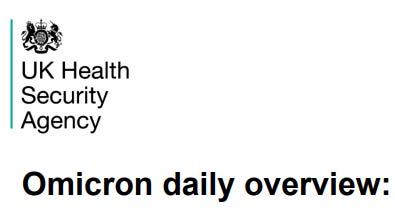As Omicron mania continues in the UK, we have seen a rise in hospitalisations from 16 confirmed cases and 4 SGTF cases yesterday to 65 combined cases today. Over a 200% increase but on very small numbers. Are we going to see an increase in reported hospitalisations in the media over the coming weeks and months? Of course we will, it’s winter and Omicron is highly transmissible, but is there potential for this number to be exaggerated?
Firstly, as you can see above, yesterday’s cases were split by confirmed cases and SGTF cases. SGTF cases are where the S gene is not present when testing, making it highly likely to be Omicron, but not for certain. Today, confirmed cases and SGTF cases have been combined, making a larger figure for the media to report on. Using yesterday’s total, 20 percent of the combined cases were SGTF. On the same ratios, today would have seen 13 SGTF cases and 52 confirmed cases. A small difference at the moment but as numbers rise, this will make a big difference. I’m curious as to why they have combined them all of a sudden.
More interesting, is a little caret symbol (^), next to the hospitalisations figure, which made me wonder if cases are going to rise much higher than they would have done, without a definition change. This caret symbol stated underneath that the number had increased due to a switch in the data set as described in Appendix 2. It says this data is lagged and so incomplete.
Appendix 2 defines hospitalisations. Up until today hospitalisations were “cases presented to emergency care and admitted or transferred at the end of their emergency care stay, who have a positive SARS-CoV-2 test either:
- With 28 days before presentation to emergency care
- On admission
- During their admission in hospital”
From today this has changed to “cases with presentation to a type 1 A&E….who have a positive SARS-CoV-2 test either:
- Within 14 days prior to admission
- Within 1 day post admission”
Looking at each change in turn, we start with the change from cases presented to “emergency care” to a “type 1 A&E”. Type 1 A&E departments account for the majority of A&E attendances whilst emergency care suggests the most serious of attendances. Could this change increase the amount of potential patients, who will be included on the hospitalisations list, subject to having a positive test? I would think it does.
Next, the positive test has been changed from “28 days before presentation to emergency care” to “within 14 days prior to admission”. Now at first, I thought reducing the number of days before going to hospital was a good thing, because a positive test 28 days before emergency care is a long time. However, the change from “emergency care” to “admission” again suggests less severely ill patients will now be included in the count.
Finally, “during their admission in hospital” has been reduced to “within 1 day post admission”. Whilst this won’t increase numbers, it may however, reduce the statistics showing how many people caught Omicron whilst in hospital (which with other variants has always been a lot!).
I may just be being pedantic but these changes were obviously done for a reason. If they result in an increase in reported hospitalisations for the media to feed on, resulting in policy changes and/or further restrictions then they should be properly scrutinised, however minor the changes are. If I have misunderstood or you think differently, let me know.




Not pedantic at all. Changing the definitions like this and ruining the raw data is such a schoolboy error that it can only have been done with an intent to obfuscate.